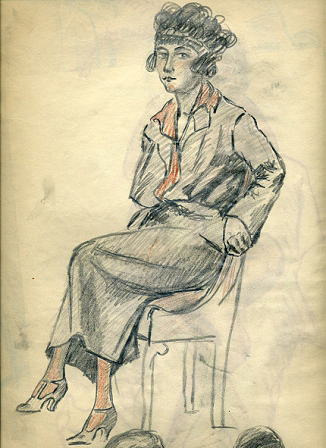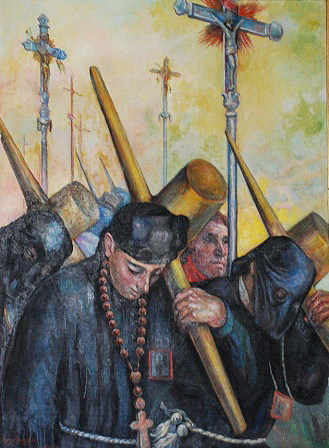The piece of the month of January 2015
"THE PROCESSION", BY KARLE GARMENDIA
José María Muruzábal del Solar
Ph.D. in Art History
Carlota Garmedia Aldaz, known as Karle Garmendia, was born in the Navarre town of Oroz Betelu on January 15, 1898. Karle's father was Leopoldo Garmendia Goicoechea (Oroz Betelu, 15/11/1870 - 28/10/1942), a man of relevance within his community where he was mayor, councilman, municipal judge, councilor of the Irati society, etc. His mother's name was Salomé Aldaz Jaurrieta (Aoiz, 3/16/1870 - Mexico, 5/10/1965). His father, Miguel Aldaz, was mayor of Aoiz, deputy and owner of the Señorío de Górriz. Given his early artistic inclination, he soon attended the School of Arts and Crafts of Pamplona, which was the center of Navarre where one could start programs of study artistic at that time. Karle Garmendia is reported to have attended the aforementioned school between 1912 and 1916 approximately. At that school she presumably had Enrique Zubiri as her teacher. She also attended classes at Javier Ciga's academy. This presence of Karle Garmendia in the academy of the master Ciga must be dated in the years immediately before 1920.
After this apprenticeship, in the first part of the twenties, the painter moved to Paris to study. In the French capital she attended courses at the prestigious Colarossi Academy and the School of Fine Arts, being the first woman from Navarre to do so. In this sense, Karle Garmendia is a woman well ahead of her time; she decided to devote herself to painting, did not hesitate to move to Paris to study and married an artist, Higinio Blat, in the town of Oroz Betelu, on September 29, 1926, being witness of the wedding the master Javier Ciga. For more than 35 years she lived an intense journey through France, Italy, the United States and Mexico. Undoubtedly, a very interesting biography of a Navarrese woman born at the end of the 19th century.

Drawing by Karle Garmendia
From then on, she lived in the French town of Pau, very close to the Pyrenees. The outbreak of the Spanish Civil War in 1936 disrupted the life of Karle Garmendia and her family final. In 1947 the family obtained safe conduct to emigrate to Mexico. Karle's own siblings and his mother Salomé Aldaz were already there. They settled in Mexico in 1948, after a fruitful artistic journey through the United States. In 1951 they moved to Hermosillo, capital of the state of Sonora, in the north of the country. In Sonora, Higinio Blat was the founder and first director of the Academy of Plastic Arts of the University of Sonora. Karle Garmendia accompanies him in this endeavor and acts as a teacher at the academy.
After a fruitful decade in Hermosillo, at the end of 1959, the Blat Garmendia family returns definitively to Spain, settling in the capital of Navarre. They spent the sixties and seventies in Pamplona, spending time in the house of Oroz Betelu, then owned by his brother Miguel José, who remained in Mexico. During these years, Karle returned to Navarrese themes, taking a special interest in the history and traditions of her land as an aesthetic motif for her paintings. The artist died in Pamplona on July 9, 1983.

Karle Garmendia
The painting we present here was donated by the artist to the Town Hall of her native town. It represents a scene of ethnographic character such as the pilgrimage made by the natives of the area, since time immemorial, to the sanctuary of Roncesvalles. This is a profound, intimate work of great dignity. The whole foreground is occupied by the pilgrims, in penitential attitude, with their parish crosses. According to several testimonies, the man in the second term, with red handkerchief, is Karle Garmendia's own father.
It is a composition of sure drawing and well toned and balanced color; the whole work is subordinated to the feeling of the color and the expressive sense of the work. The composition in this subject of representations poses the figures always in the foreground, occupying most of the surface of the painting in question, transmitting strength and energy. They are figures of great strength, haughty, that seem to want to remember the intention with which they are elaborated; it is about representing the spirit of the old kingdom of Navarre. The expressionist intention with which the work is elaborated is evident.

The procession, by Karle Garmendia
Oil / board. 120 x cm.
C. 1930. Oroz Betelu Town Hall
Recently we have tried to vindicate the figure of this Navarre painter, perhaps the first prominent woman in the visual arts of our Community. In August 2014 a exhibition of her work was developed in the premises of the Town Hall of Oroz Betelu, while the Foral Parliament remembered her with the organization of an anthological exhibition , in its conference room of exhibitions, in January of this year 2015. We hope, with all this, to contribute to this purpose.
bibliography
-MURUZÁBAL DEL SOLAR, J.M., "Karle Garmendia, pintora", Revista Zangotzarra, nº 17, 2013.
